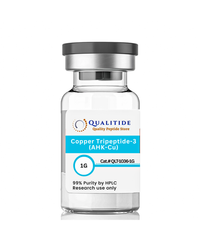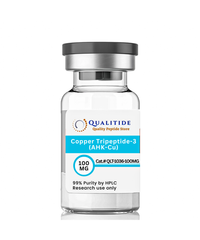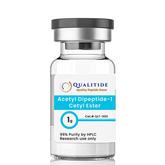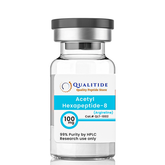Product Usage: This PRODUCT, exclusively offered by Qualitide, is for RESEARCH USE ONLY. It is intended for in vitro testing and laboratory experimentation. All information on this website serves educational purposes only. Introducing this product into humans or animals is illegal. It must be managed by licensed professionals only. This is not a drug, food, or cosmetic and should not be branded or misused as such.




Description
xCopper Tripeptide-3 (AHK-Cu) is another copper peptide composed of amino acids alanine, histidine, and lysine, with a copper ion coordinated by various parts of these three amino acids.(1) This peptide appears to be naturally present in the bloodstream and has been suggested as a potential element in regulating the growth, development, and apoptosis of vascular endothelial cells.
AHK-Cu, also known as copper AHK, has been researched for its potential in hair growth and supporting skin tissue integrity. This peptide has been suggested to exhibit its potential primarily on fibroblasts, responsible for maintaining and growing the extracellular matrix (ECM) components surrounding the cells. Fibroblasts also appear to secrete various biological substances, including the Vascular Endothelial Growth Factor (VEGF), which is suggested to promote the formation of new blood vessels.
The copper ion in AHK-Cu is suggested to be involved in enzyme activity related to collagen and elastin synthesis. These two proteins are critical components of the extracellular matrix and play a role in maintaining the skin tissues' structural integrity. Copper ions are also suggested to exhibit antioxidant properties.
Chemical Info(2)
Molecular Formula: C15H25CuN6O4
Molecular Weight: 416.9 g/mol
Synonyms: ALA-HIS-LYS-CU, L-Alanyl-κN-L-histidyl-κN,κN3-L-lysinato(2-)]copper Monohydrochloride
Research and Clinical Studies
AHK-Cu Peptide and Antioxidative Potential
AHK-Cu is posited to have potent antioxidant qualities, primarily due to its distinct amino acid structure. Based on the antioxidative properties of this peptide, studies have suggested its potential in amplifying hair follicle size, which may increase growth. This peptide has been the focus of numerous in-vitro investigations, particularly concerning its role in hair growth. These studies uniformly suggest AHK-Cu's potential to foster hair follicle development. In addition to hair growth, AHK-Cu's scope of application may extend to cell aging, wound healing, and other areas, according to researchers. They posit its potential role in boosting dermal cell multiplication and survival, both of which are essential in collagen production. Collagen is a vital element for maintaining skin cell turnover and function, and the increased cell activity provided by AHK-Cu may facilitate this process.(3)
AHK-Cu Peptide and Hair Follicle Development
Researchers posit that the tripeptide AHK-Cu may potentially stimulate the proliferation of dermal fibroblasts, a type of cell that produces substances like vascular endothelial growth factor (VEGF), which are considered to be crucial for the growth of blood vessels. AHK-Cu may also reduce the secretion of transforming growth factor-beta1 by dermal fibroblasts.
In a recent study,(4) the potential of AHK-Cu on hair growth was investigated. It was suggested that the peptide may promote the elongation of hair follicles and the proliferation of dermal papilla cells (DPCs), which are specialized fibroblasts with a potential to increase the growth and development of hair follicles. Moreover, the authors suggested that the presence of AHK-Cu may have reduced the number of apoptotic dermal papilla cells. Further analysis suggested that the peptide may have increased the ratio of Bcl-2/Bax, and potentially decreased cleaved caspase-3 and PARP levels, two markers of cell death. The Bcl-2/Bax ratio is suggested to play a potential role in the regulation of apoptosis. Bcl-2 is posited as an anti-apoptotic protein that apparently inhibits cell death, while Bax is suggested to be a pro-apoptotic protein that promotes cell death. Thus, a higher Bcl-2/Bax ratio is posted as a predominance of Bcl-2, which may inhibit apoptosis and apparently promotes cell survival. Ultimately, the researchers suggested that AHK-Cu “stimulated the elongation of […] hair follicles […] and the proliferation of DPCs in vitro.” Based on these observations, the researchers commented, “The present study proposed that AHK-Cu promotes the growth of [...] hair follicles, and this stimulatory effect may occur due to stimulation of the proliferation and the preclusion of the apoptosis of DPCs.”(4). Other researchers delving into this trial also noticed that the peptide may have interacted with VEGF and Transforming Growth Factor Beta 1 (TGF-β1). TGF-β1 is researched for its role in cell proliferation, differentiation, and apoptosis. It is posited to be involved in several cellular processes, including the regulation of immune responses and wound healing. By potentially downregulating TGF-β1, AHK-Cu may alter these cellular processes, possibly affecting cell growth and the immune response at a cellular level. On the other hand VEGF is researched for its role in angiogenesis, the formation of new blood vessels from pre-existing vessels. The upregulation of VEGF by AHK-Cu might imply an enhanced potential for angiogenesis, which could influence nutrient and oxygen supply at the cellular level.(5)VEGF specifically is posited to foster the development of blood vessels surrounding hair follicles. This action potentially aids in delivering nutrients and oxygen to the hair follicles, thereby supporting hair growth.
AHK-Cu Peptide and Alopecia Research
The study examined the potential of two formulations containing growth factors and peptides such as vascular endothelial growth factor, basic fibroblast growth factor, insulin-like growth factor-1, keratinocyte growth factor, and copper tripeptide 1 and related peptides such as AHK-Cu, suspended in a sterile vehicle. The experiment investigated the potential cytotoxicity of these factors using in vitro keratinocyte and fibroblast cell assays. The formulations were also investigated for their potential for hair growth and hair follicle viability in cases of secondary alopecia.(1)
The authors suggested that both formulations appeared to produce a positive response regarding hair growth in the animals. The formulations also were posited to be impactful when tested alongside agents that may be associated with alopecia. Researchers Rinky Kapoor et al. state, “Results seem encouraging enough to warrant a trial in [...] secondary alopecia.” (1)
AHK-Cu Peptide and Skin Tissue Integrity
Preliminary lab studies have suggested that the core molecule of the peptide, AHK, may stimulate the growth of fibroblast cells and the production of collagen. Notably, AHK appears to improve the survival and multiplication of dermal fibroblasts, which are researched for their potential for generating vital skin proteins like collagen. In experiments with normal dermal fibroblasts, AHK was observed to apparently boost both cell growth and viability, alongside enhancing collagen type I production. This conclusion was drawn by measuring collagen type I levels produced by fibroblasts in a cell culture following exposure to varying concentrations of AHK. The studies indicated that AHK's presence may have raised collagen type I production, with a threefold increase compared to the control group. These results imply that AHK could potentially rejuvenate the extracellular matrix and contribute to skin function.(6)
AHK-Cu peptide is available for research and laboratory purposes only. Please review and adhere to our Terms and Condictions before ordering.
References
- Kapoor R, Shome D, Vadera S, Kumar V, Ram MS. QR678 & QR678 Neo Hair Growth Formulations: A Cellular Toxicity & Animal Efficacy Study. Plast Reconstr Surg Glob Open. 2020 Aug 25;8(8):e2843. doi: 10.1097/GOX.0000000000002843. PMID: 32983753; PMCID: PMC7489598. https://www.ncbi.nlm.nih.gov/pmc/articles/PMC7489598/
- AHK-Cu, ChemBK. https://www.chembk.com/en/chem/AHK-Cu
- Kecel-Gunduza, S., Kocb, E., Bicaka, B., Kokcub, Y., Ozela, A. E., & Akyuzc, S. (2020). IN SILICO ANALYSIS FOR CHARACTERIZING THE STRUCTURE AND BINDING PROPERTIES OF ALA-HIS-LYS (AHK) TRIPEPTIDE. The Online Journal of Science and Technology-July, 10(3).
- Pyo HK, Yoo HG, Won CH, Lee SH, Kang YJ, Eun HC, Cho KH, Kim KH. The effect of tripeptide-copper complex on human hair growth in vitro. Arch Pharm Res. 2007 Jul;30(7):834-9. doi: 10.1007/BF02978833. PMID: 17703734. https://pubmed.ncbi.nlm.nih.gov/17703734/
- Sadgrove NJ, Simmonds MSJ. Topical and nutricosmetic products for healthy hair and dermal anti-aging using "dual-acting" (2 for 1) plant-based peptides, hormones, and cannabinoids. FASEB Bioadv. 2021 Jun 6;3(8):601-610. doi: 10.1096/fba.2021-00022. PMID: 34377956; PMCID: PMC8332470. https://www.ncbi.nlm.nih.gov/pmc/articles/PMC8332470/
- Patt, L. M., & Procyte, A. (2009). Neova® DNA Repair Factor Nourishing Lotion Stimulates Collagen and Speeds Natural Repair Process. skin, 1, 2.
Shipping & Return
xReturns Policy
At Qualitide, we are committed to ensuring your satisfaction with our products. Our Satisfaction Guarantee policy allows you to return or exchange any item within 14 days of receiving your order if you are not completely satisfied. Return/Exchange Eligibility To be eligible for a return or exchange: The item must be in its original condition as received, unworn or unused, with tags attached, and in its original packaging. You must provide the receipt or proof of purchase..
If you need to return an item, simply login to your account, view the order using the "Complete Orders" link under the My Account menu and click the Return Item(s) button. We'll notify you via e-mail of your refund once we've received and processed the returned item.
Shipping
At QUALITIDE, we aim to make your shopping experience simple and smooth. Here’s how we handle shipping: Processing Time We process all orders within 0 to 1 business day. Orders placed after business hours, on weekends, or on holidays will be processed the next business day. Delivery Time Once processed, delivery takes 2 to 3 business days, depending on your location and the shipping carrier. Total Delivery Time From placing your order to receiving it, the total time is 2 to 4 business days, including both processing and shipping.
Disclaimer
xAll articles and product information provided on this website are for informational and educational purposes only. The products offered on Qualitides are intended solely for in-vitro research purposes. In-vitro studies ("in glass" studies) are conducted outside of the body. These products are not medicines or drugs and have not been evaluated or approved by the FDA to prevent, treat, diagnose, or cure any medical condition, ailment, or disease. Any form of bodily introduction or administration of these products into humans or animals is strictly prohibited by law. By using this website, you acknowledge and agree to comply with all applicable regulations and restrictions related to the products provided by Qualitides.
- Choosing a selection results in a full page refresh.








